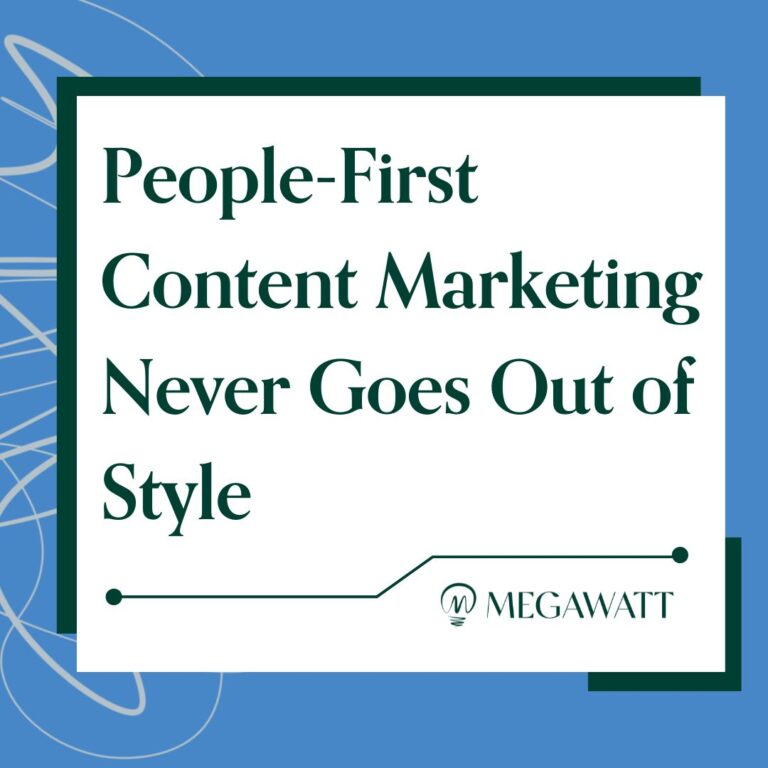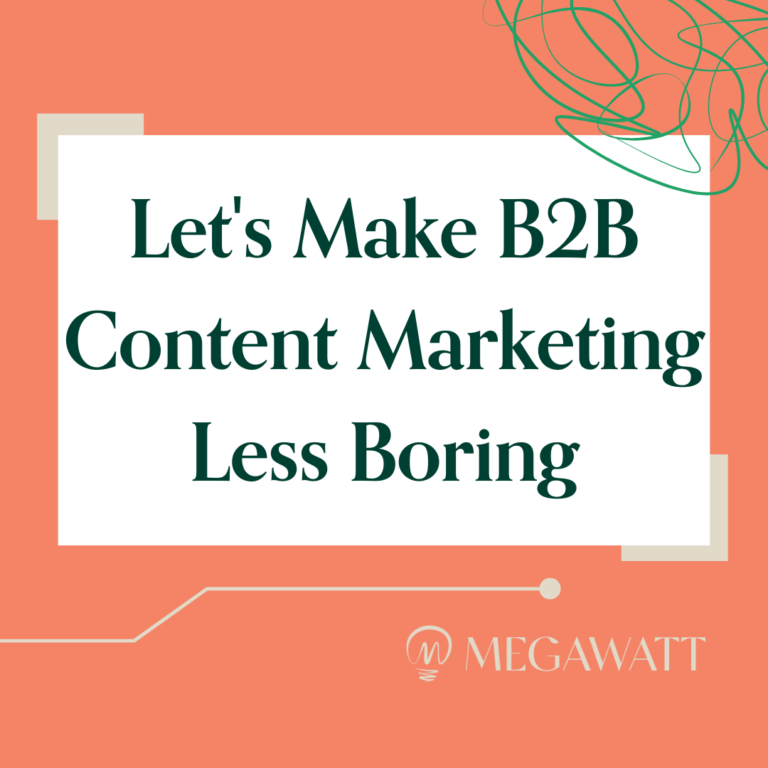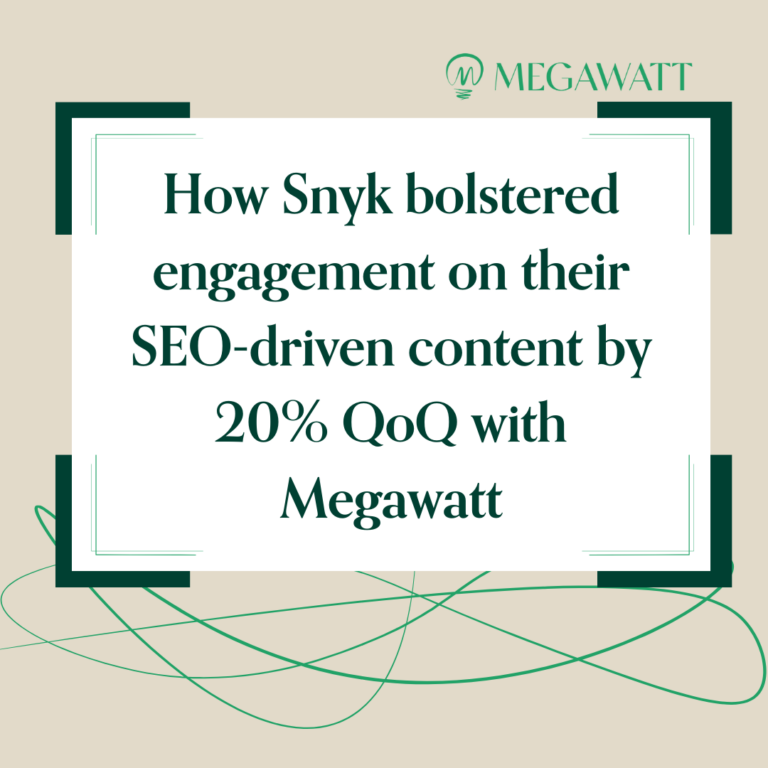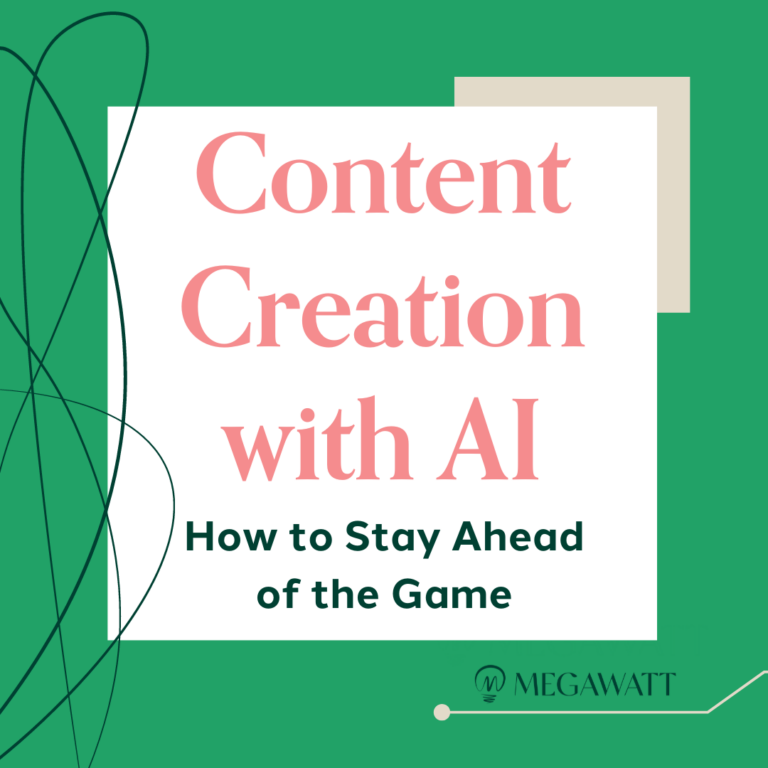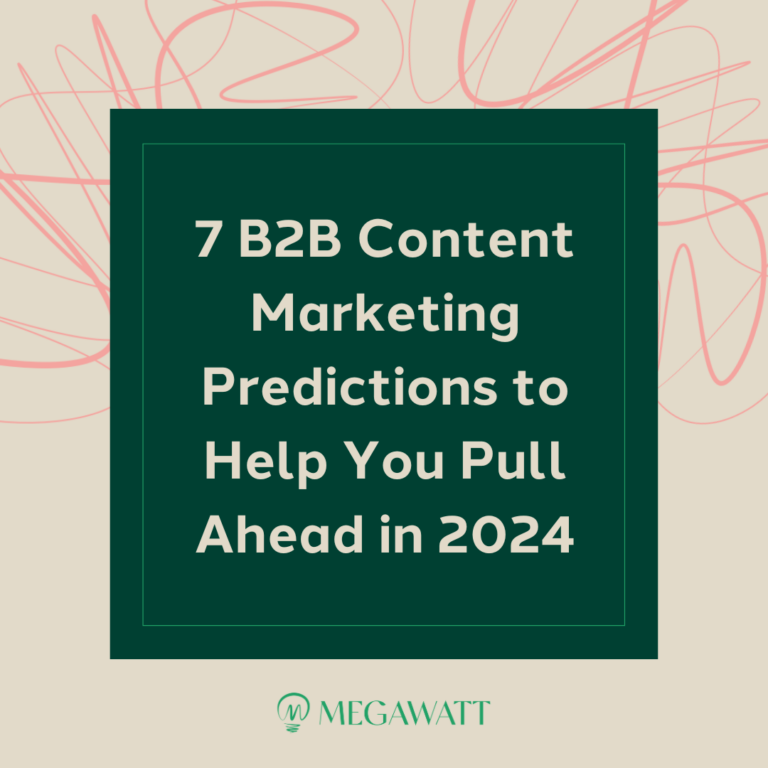Recent research shows that 71% of B2B marketers feel content marketing has become critical to their organization in the past year. Yet, alarmingly, only 29% say they consider their organizations extremely or very successful with content marketing.
To seize opportunities in content marketing, marketers must develop a clear strategy outlining how content can impact their business goals and help them reach the right people, at the right time and on the right channels.
In this comprehensive how-to guide, we’ll cover the basics of:
- What is B2B content marketing?
- What is a B2B content marketing strategy? (And why you need one)
- 6 Steps to build your own B2B content strategy
- Next steps with Megawatt
What is B2B Content Marketing?
The term content marketing is rather vague. At its most basic level, content marketing is a way to promote your company, product, and service by connecting with audiences through digital content assets, including videos, blogs, social media posts, white papers, and more. For B2B marketers, content marketing is an effective technique to drive awareness, generate leads, and convince prospects to purchase a B2B product or service.
Content marketing often supplements and enhances the work of other departments — including sales, support, and customer success — by feeding audiences consistent, well-defined information about your company, product, service, use cases, and vision.
Creating Valuable and Engaging Content for B2B Audiences
The content you create for a B2B audience will depend on their motivations, preferences, and where they sit in the marketing funnel. Each piece of content should:
- Consider the needs of your audience: Does your target audience have a specific pain point they are trying to solve? Or are they more interested in educational resources that help them grow and excel in their role or career? When creating content, you must cater to the needs of your audience and ensure you provide them with value in return for their attention and readership or viewership.
- Consider how your audience likes to consume content: Does your target audience congregate on Reddit, read in-depth case studies about a product in action, or prefer watching quick video content vs. reading words on a web page? When developing content, you must consider the preferences of your target audience.
- Be easily findable and accessible: Content is only valuable if people can view and use it. Your content must be findable for your target audience — whether through robust keyword research and SEO tactics, which lead them to your content organically, prominent placement on your website, or custom distribution strategies which bring your content directly into the hands of your readers.
Content Distribution and Promotion Strategies
Content ready to be shared with the world gets distributed in three main ways:
- Paid media is content you pay for. This typically includes ads, sponsored material, or press release distribution via wire. Paid media can be online (Google Ads, Facebook Ads) or offline (print ads, TV ads).
- Owned media is content that you create and own. This may include content on your company website, blog, or social media posts.
- Earned media is content other people write about you, like reviews or articles in newspapers and magazines. This also includes shares of your owned content — via social media, for example.
Distributing content through owned channels is most often the solution for content created as part of a content marketing program. It’s also what we believe is the most effective method of sharing your content. By focusing on owned channels, you can nurture a highly-relevant and engaged audience without being beholden to algorithms on third-party channels that dictate who sees your content and when.
What is a Content Marketing Strategy?
A content marketing strategy outlines how you’ll use content to connect with your target audience and achieve goals relevant to your business.
At its most basic level, a content strategy will include:
- Goals and Objectives: A clear definition of what you hope to achieve with your content and how you want it to impact your business.
- Target Audiences: Information about the people you are trying to reach through your content and which content (topics and types) you’ll develop for each audience.
- Marketing Channels and Distribution Tactics: The channels and strategies you will use to share your content once it’s produced.
A content plan usually suplements a content strategy. A content plan outlines how you’ll use your budget and resources effectively, who will take ownership of each tactic, how you’ll track success, and a timeline in which content deliverables will be created and distributed. The plan may or may not be part of the overarching marketing strategy document.
B2B Marketing Goals, Objectives, and KPIs
The type of content you create will depend on the goals of your content program. Common B2B content marketing goals include:
- Increasing brand awareness
- Generating new leads
- increasing customer loyalty and retention
Below, we outline common goals and samples of corresponding objectives, tactics, and KPIs that a content strategy centered around those goals may include.
| Goals | Sample Objectives / Tactics | Sample KPIs |
| Brand Awareness and Education | Thought leadership content in industry specific publications SEO-centric content | Increase website traffic Increase social media follows or mentions Increase in branded searches via search engines |
| Lead Generation and Nurturing | Gated ebooks Blogs focused on questions / concerns of target audience Case studies | Increase in email addresses or prospect data collected Increase in email and/or blog subscribers and content downloads Reduced timeline to close prospects Increase in new customers |
| Customer Loyalty and Retention | Co-authored blogs or co-presented webinars / events Blogs that solve common product pain points and how to navigate them | Reduced churn rates Increase in the lifetime value of customers |
B2B Target Audiences: Identification and Segmentation
For B2B marketing, target audiences can include anyone who supports the development of your company/product, uses or evangelizes your product, or influences a buying decision. These audiences look like:
- Investors: Those who provide monetary support or expertise to drive the growth and development of your company. This audience is typically interested in content about what makes your approach unique, how you are disrupting a market, what expertise your team / company brings to the table, and what the potential return on investment looks like.
- Stakeholders: Anyone who influences the decision to buy or use your product. This audience wants to know the impact your company’s solution or service will have on their company, and what (if any) considerations and accommodations are necessary to onboard your product, maintain your service, etc.
- Buyers / Decision Makers: The person(s) who purchases your product or service. Buyers need concrete information about the cost of your product and the ongoing maintenance required. They also need clear information about the value of your product or service and innovative ways other users find value from your company.
- Users: The people who use your product or service. This audience needs practical information, including how-to guides, FAQs, and support-based content. In B2B marketing, specific user-based audiences can be challenging to reach and engage — like developers, who are notoriously skeptical of traditional marketing and advertising efforts.
Identifying audiences is only the first step in a B2B content marketing strategy. Segmentation is also crucial. Segmenting audience members — via information collected and maintained in your CRM tool or by pursuing custom content distribution strategies for each audience — is the best way to ensure you connect the right people to the right content. This will drastically improve engagement and the return on your content investment.
B2B Marketing Channels
A marketing channel is the outlet or platform through which you connect and communicate with a target audience. Some of the most popular channels for B2B marketers include:
- Social Media: Not all social media is created equally. The channels that appeal to B2B audiences differ from those that appeal to B2C audiences. That’s why Linkedin is a popular channel for B2B marketing, whereas Instagram is not. Linkedin is a professional network; members go to the channel expecting to view content relevant to them professionally — including products or services that may benefit their company.
- Email: Email is a suitable marketing channel for B2B and B2C marketing. In the world of B2B marketing, email is most often used to nurture leads (via nurture streams that retarget potential customers who have engaged with your brand in some way) and increase customer loyalty and retention (by sharing product updates, case studies, and answers to commonly asked support questions). Email may also support top-of-funnel brand-building techniques — via a newsletter that shares interesting industry insights or company news, for example.
- Blog or Company Website: Blogs and company websites are key channels for B2B content marketers and will typically include content relevant to all marketing funnel stages. TOFU content may include your company homepage, about page, and thought leadership blogs. In contrast, MOFU / BOFU content may take the form of customer case studies, product landing pages (or competitor battle cards), and FAQ pages. Many blogs feature content built to support an SEO strategy. With SEO, you can help people discover your content organically by aligning content with the most frequently asked questions or topics your audience searches for online.
- Events: Whether virtual or in-person, events are a key part of B2B marketing. Tradeshows, customer meetups, industry conferences, and webinars help you increase brand awareness, generate leads, and nurture relationships with prospects and customers.
- Indirect Marketing Channels: In B2B marketing, various indirect marketing channels may come into play. Indirect marketing channels involve third parties, such as resellers, distributors, or agents.
6 Steps to Build Your Content Marketing Strategy
Once you get a handle on all the elements that go into a marketing strategy — from goals and objectives to audience identification and channel development — it’s time to build one for yourself. You can build a comprehensive B2B content marketing strategy by following six simple steps:
1. Identify your goals: Define the areas of your business that you want to impact with content. Connect each goal to a clear KPI, which you’ll use to track the impact of your content efforts.
2. Develop audience personas: Define who you’d like to reach via content efforts. Focus less on demographic information and more on the needs and preferences of each identified cohort, so you can build content that provides actual value.
3. Connect audiences and channels: Track where your audience members hang out and where they will likely find and engage with your content. This will determine what types of content you create and how you will distribute it to your target audience.
4. Get creative: Use everything you’ve learned about your audience’s needs and preferences and the places they are most likely to consume your content, to build a list of content types and topics you’ll create. These may include blog posts, videos, ebooks, social campaigns, and more.
5. Make a plan: Turn those ideas into action by creating an editorial or content calendar outlining when you’ll create each piece of content and who will take ownership of each project.
6. Analyze and revise: Once you’ve published and distributed your content, track its success! Go back to your original goals and KPIs to determine what’s working and what’s not working. From there, adjust as necessary. We recommend reviewing content performance at least twice yearly and tracking it against your goals and KPIs to refine your content marketing strategy. Remember that certain content (ex., content built for SEO) may take longer to generate results than other campaigns.
6 Steps to Build Your Content Marketing Strategy: Free template
Megawatt’s B2B Content Strategy Services
Ready to bring in the experts? Megawatt can help you with every step of the content process — from strategy and idea generation to content production, distribution, and performance analysis. Partnering with the team at Megawatt will bring your marketing strategy to the next level. Click the button below to see for yourself!
